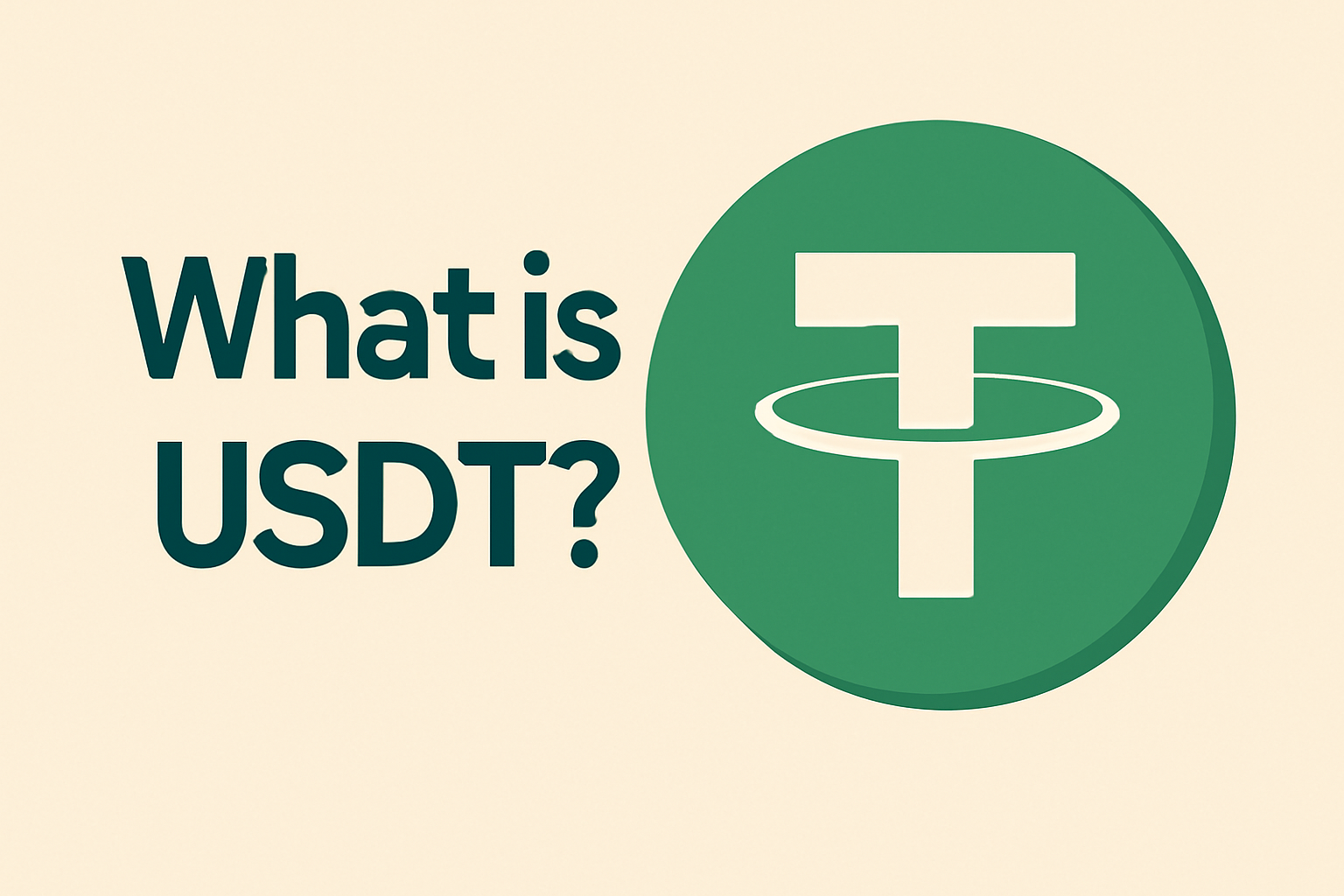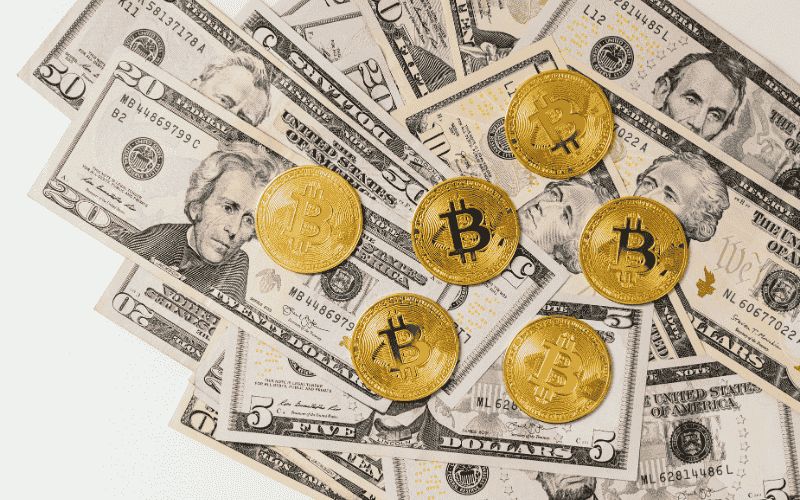To keep its worth over time, Tether (USDT) is a stablecoin, which is a type of cryptocurrency. USDT, unlike Bitcoin and Ethereum, is linked to the U.S. dollar to stabilize prices by keeping a 1:1 value ratio.

What is Tether? (Understanding the concept behind Tether)
Although it launched in 2014, Tether (USDT) is one of the most popular stablecoins in terms of value. Tether is intended to keep its value fixed by being pegged to an asset, most often the U.S. dollar. This is different from cryptocurrencies like Bitcoin, whose values change all the time. As its name suggests, Tether tries to keep prices stable by keeping its value at 1:1 with the dollar.
As a blockchain-based digital currency, Tether makes it easy to send money between different blockchain networks. Tether was one of the first stablecoins to hit the market, and it now offers a number of fiat-pegged stablecoins, such as:
- USDT (U.S. Dollar)
- EURT (Euro)
- MXNT (Mexican Peso)
- CNHT (Chinese Renminbi)
- XAUT (Gold-backed)
By using blockchain technology, Tether makes it easier to send money across borders and reduces the value loss that comes with changes in currency exchanges.
What are Tether tokens used for in digital finance?
The value of Tether tokens is equal to one real-world dollar (1:1). They are digital stablecoin assets. There will be less price fluctuation with this peg, and Tether says it will make the cryptocurrency a safer and more stable way to send money. These tokens let traders and organizations like cryptocurrency exchanges, digital wallets, and payment processors circulate funds globally. Some sites also accept Tether coins as payment.
Tether works with many popular blockchain networks, such as Algorand, Avalanche, Bitcoin Cash (through the Simple Ledger Protocol), Ethereum, EOS, Liquid Network, Omni, Polygon, Tezos, Tron, Solana, and Statemine. This support for multiple chains makes the digital asset market more open and flexible for users.
How does the Tether mechanism ensure price stability?
Tether established a blockchain-based asset with price stability to reduce volatility in cryptocurrencies. Due to its constant pricing, many investors store funds in Tether, especially amid significant market volatility.
Upon meeting certain circumstances, smart contracts execute automatically with Tether. Smart contracts using Tether or other stablecoins help reduce the risk of value changes in volatile cryptocurrencies, delivering more predictable and trustworthy results.
What’s inside Tether’s reserve structure?
To keep its value, Tether supports its tokens with a mix of liquid and alternative assets. Take a look at this full list of its reserve allocations:
Liquid Asset Allocation (82.3%)
- U.S. Treasury Bills: $94.47 billion
- Overnight Reserve Repurchase Agreements: $14.10 billion
- Term Reverse Repurchase Agreements: $3.08 billion
- Money Market Funds: $6.51 billion
- Cash and Bank Deposits: $108 million
- Non-U.S. Treasury Bills: $69 million
Alternative Asset Allocation (17.7%)
- Secured Loans: $8.19 billion
- Bitcoin Holdings: $7.86 billion
- Precious Metals: $5.32 billion
- Other Investments: $3.98 billion
- Corporate Bonds: $0.01 billion
Many investors see Tether as a digital dollar, which affects its usage in the cryptocurrency ecosystem. Tether is essential for digital market liquidity and stability because of this notion.
Before Tether, crypto traders had few ways to transfer money across blockchains without converting to fiat currency. It was common for investors to sell Bitcoin and reinvest in another cryptocurrency by withdrawing the proceeds as fiat money and re-depositing it into a platform.
This changed when Tether allowed investors to sell digital currencies and keep them in a stablecoin. Users may streamline trading tactics and preserve money without leaving the crypto community by avoiding extreme volatility.
USDT price trends: How has Tether performed over time?
USDT has seen significant price changes despite Tether’s assertions that its tokens are resistant to cryptocurrency market volatility. Investors must investigate any digital asset before buying since there is no way to predict USDT’s price.
USDT plunged in mid-2017, hitting an all-time low of €0.80 in January 2018. After overcoming legal and corporate issues, its value rose to €0.90 by spring 2020. It fell again to €0.80 in 2021.
Since then, USDT has steadied and is trading close to 1 U.S. dollar.
What are the main uses of Tether in crypto transactions?
Tether’s main use case is as a store of value and payment medium in the blockchain ecosystem and between apps. Many companies accept it for digital payments. Tether partners with Travala, which lets customers book flights and hotels using cryptocurrencies like USDT.
Online transactions are Tether’s principal use, but it may also be a low-volatility investment for cryptocurrency investors.
Is Tether a safe and smart investment choice?
Tether’s 1:1 backing with the U.S. dollar makes it seem safer, but it is still a cryptocurrency and vulnerable to the crypto market’s hazards.
Cryptocurrency instability and price swings led to the establishment of stablecoins like Tether. It is vital to realize that stablecoin investment is very speculative. Instead of firm performance and cash flow, investor mood and market dynamics drive cryptocurrency values.
If you use Tether primarily to swap cryptocurrencies, consider changing to fiat cash to better meet your financial objectives. You should base your crypto investing selection on your goals and risk tolerance.
Tether advantages and risks explained
Pros of Tether (USDT):
Reduced Price Volatility:
Tether is meant to keep a fixed value, usually linked to the U.S. dollar. This makes it less prone to the big price changes that happen with other cryptocurrencies.
Lower Transaction Costs:
Using Tether can help keep the fees that come with exchanging regular currency for other types of currency as low as possible. It is often cheaper to trade in USDT than to send and receive standard currency.
Trading Flexibility:
Many blockchain networks and blockchain platforms accept Tether, which makes dealing and sending money easier and more flexible.
Cons of Tether (USDT):
Limited Transparency:
Not enough information is available about how the company manages and makes decisions about its capital assets.
Allegations of Market Manipulation:
There have been claims that the company manipulated the market by issuing unbacked USDT in the past to change the price of Bitcoin and other cryptocurrencies.
No FDIC Insurance:
The Federal Deposit Insurance Corporation (FDIC) and other government agencies do not protect Tether’s funds like they do deposits in regular banks. There is no government-backed safety for investors in case Tether fails, even though the company says it has enough funds.
Key takeaways for Tether (USDT) investors and users
By providing a digital asset with relatively low price fluctuation, Tether has made it much easier to transfer money into and out of the cryptocurrency environment. It gives buyers a stable way to buy and sell things and a safe way to store value in the crypto market.
But Tether does come with some risks. Market manipulation and reserve holdings transparency have plagued the currency. Remember that stablecoin stability relies on the quality, security, and transparency of its reserves.
FAQs About USDT Crypto
1. How much is $100 USDT in USD?
There is a 1:1 relationship between the USDT and the USD, so $100 USDT is about the same as $100 USD.
Can I transfer USDT to my bank account?
Yes, but not promptly. You have to use a crypto exchange or site to change USDT to a regular coin, like USD, and then take that money out of your crypto account.
Is USDT the same as USD?
Not at all. Unlike USD, USDT is a digital currency that is secure and linked to the U.S. dollar. USD is the real currency that the U.S. government issues.
